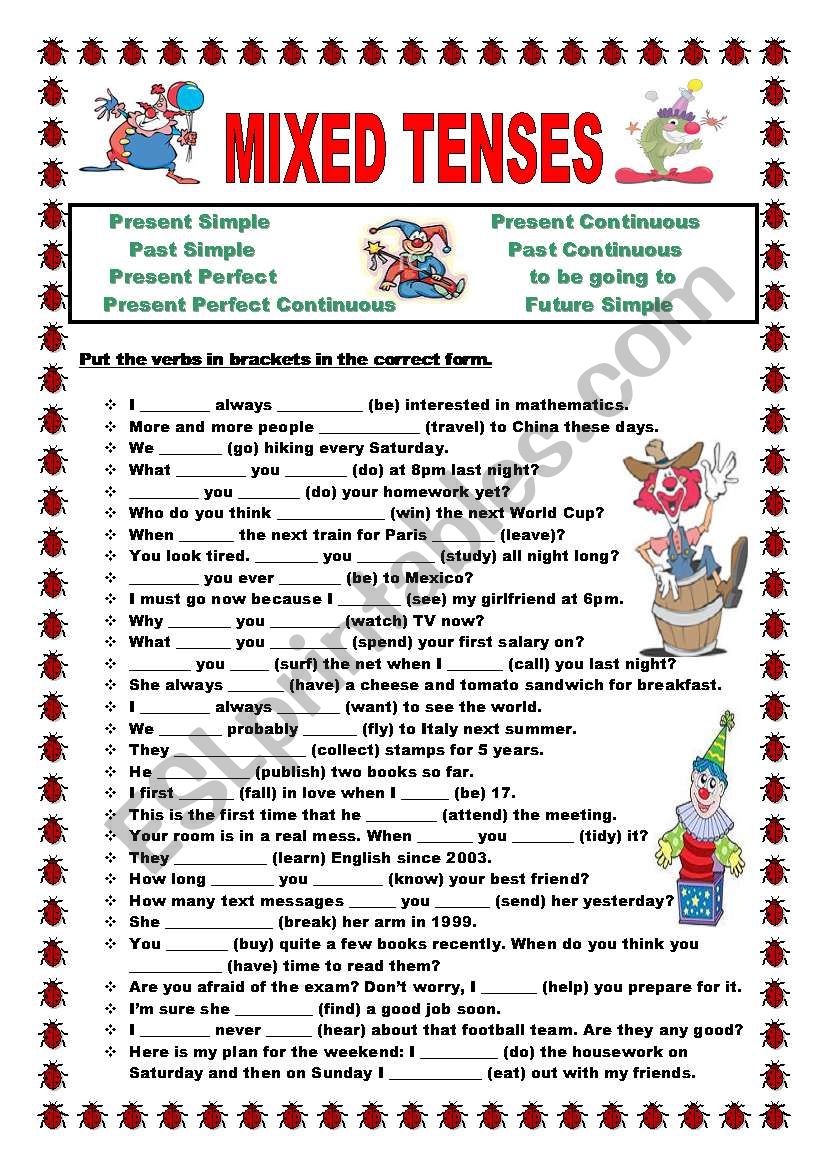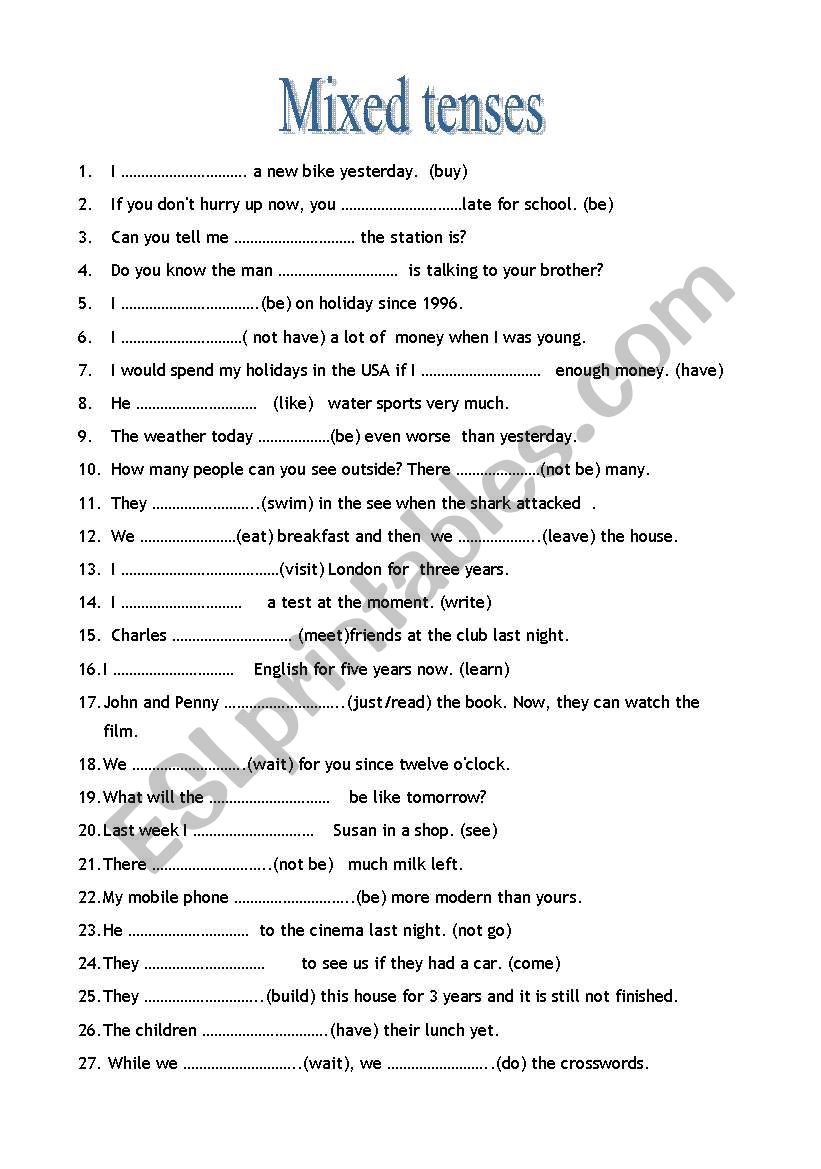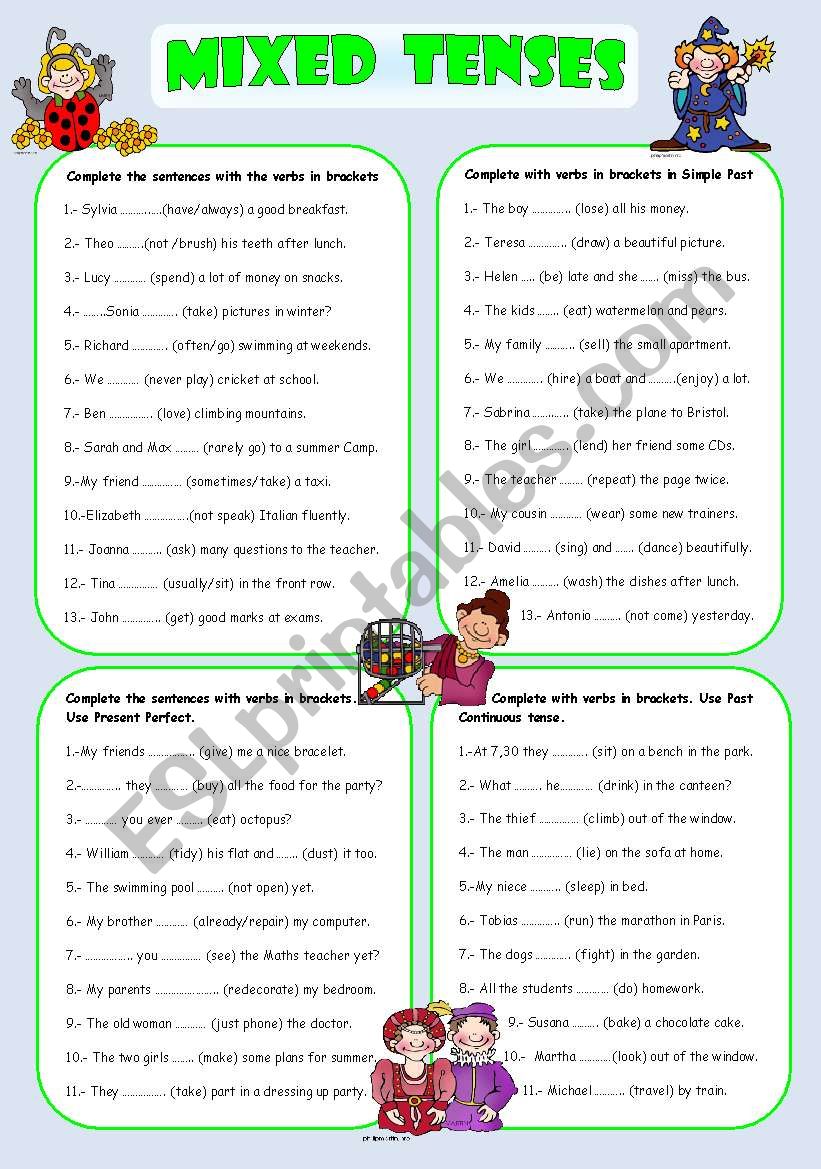
Mastering the Flow of Time: The Indispensable Role of Mixed Tenses Worksheets
English grammar, with its intricate web of rules and exceptions, often presents a significant challenge for learners. Among its many complexities, the system of verb tenses stands out as particularly daunting. With twelve active tenses and an equal number of passive counterparts, understanding when and how to use each one correctly is crucial for clear, accurate, and natural communication. While learners often begin by studying tenses in isolation – mastering the simple present, then the simple past, and so on – real-world communication rarely presents tenses in such neatly packaged units. This is precisely where mixed tenses worksheets emerge as an invaluable tool, bridging the gap between theoretical knowledge and practical application.
The Labyrinth of English Tenses: Why They Pose a Challenge

Before delving into the specifics of mixed tenses worksheets, it’s important to understand why tenses are such a common stumbling block. The difficulty stems from several factors:

- Sheer Volume: Twelve active tenses (simple, continuous, perfect, and perfect continuous forms for past, present, and future) mean a vast array of forms to memorize and apply.
- Subtleties of Meaning: Often, the difference between two tenses can be incredibly subtle, conveying nuances of completion, duration, sequence, or habit that are not immediately obvious. For example, "I have lived here for five years" (present perfect, emphasizing duration up to now) is distinct from "I lived here for five years" (simple past, emphasizing a completed period in the past).
- Irregular Verbs: The English language is notorious for its irregular verbs, which do not follow predictable patterns for past simple and past participle forms (e.g., go-went-gone, see-saw-seen). These must be memorized, adding another layer of complexity.
- Contextual Dependence: The correct tense choice often depends heavily on the surrounding context, including time expressions (e.g., "yesterday," "next week," "since 2010"), adverbs of frequency, and the relationship between multiple actions.
- Sequencing of Events: When narrating events, learners must accurately sequence actions using various past tenses (e.g., past simple, past continuous, past perfect) to convey causality and temporal order.



These challenges highlight the inadequacy of isolated tense practice for achieving true mastery. Learners might be able to correctly conjugate a verb in the simple present, but struggle when faced with a paragraph requiring them to switch seamlessly between the present perfect, future simple, and past continuous. This is precisely the scenario that mixed tenses worksheets are designed to address.

The Indispensable Role of Mixed Tenses Worksheets
Mixed tenses worksheets are exercises that require learners to use multiple different verb tenses within the same activity. Unlike single-tense drills, which might focus exclusively on the present perfect, these worksheets present scenarios where learners must actively choose the appropriate tense based on contextual clues, time markers, and the logical flow of events. They are critical because they:

- Simulate Real-World Language Use: In natural conversation or writing, sentences rarely adhere to a single tense. Mixed tenses worksheets replicate this dynamic environment, forcing learners to think critically rather than just apply a memorized rule.
- Encourage Contextual Analysis: Learners cannot simply plug in a pre-determined tense. They must analyze the entire sentence or paragraph, identify time expressions, understand the speaker’s intent, and consider the relationship between different actions.
- Highlight Distinctions Between Tenses: By presenting tenses side-by-side in a meaningful context, these worksheets help learners to internalize the subtle differences in meaning and usage that might otherwise be overlooked. For example, an exercise might ask learners to choose between "was eating" (past continuous) and "ate" (past simple) in a narrative.
- Promote Fluency and Automaticity: Consistent practice with mixed tenses helps to build the mental agility required to switch between tenses effortlessly, a key component of fluent communication.


Unlocking Potential: Key Benefits of Using Mixed Tenses Worksheets
The advantages of incorporating mixed tenses worksheets into one’s language learning journey are manifold:
- Holistic Understanding: Instead of viewing tenses as isolated grammatical points, learners begin to see them as interconnected elements of a larger system. This fosters a more comprehensive and nuanced understanding of English verb usage.
- Improved Accuracy: By constantly challenging learners to make informed choices, these worksheets reduce common errors associated with tense confusion, such as using the simple past instead of the present perfect, or vice-versa.
- Enhanced Fluency: The ability to accurately and quickly select the correct tense contributes significantly to overall speaking and writing fluency. Hesitation due to tense uncertainty can disrupt communication flow.
- Critical Thinking and Problem-Solving: Mixed tense exercises are not just about rote memorization; they require analytical skills. Learners must deduce the correct tense based on various clues, transforming a grammatical task into a mini-puzzle.
- Error Identification and Self-Correction: When provided with answer keys, learners can immediately identify their mistakes and understand why a particular tense was incorrect. This feedback loop is crucial for effective learning.
- Preparation for Standardized Tests: Many English proficiency exams (e.g., IELTS, TOEFL, Cambridge Exams) include sections that heavily test a learner’s ability to use a range of tenses accurately and appropriately in context. Mixed tenses worksheets are excellent preparation for these challenges.
- Increased Confidence: Successfully navigating complex mixed tense scenarios builds confidence in a learner’s grammatical abilities, encouraging them to engage more freely in conversations and writing tasks.
A Spectrum of Engagement: Types of Mixed Tenses Worksheets
Mixed tenses worksheets come in various formats, each offering a unique way to engage with the material:
- Fill-in-the-Blanks with Context: This is perhaps the most common type. Learners are given sentences or paragraphs with verbs missing, and they must choose the correct tense form based on the surrounding context and time expressions.
- Example: "Yesterday, while I __ (walk) in the park, I suddenly __ (realize) that I __ (forget) my keys at home."
- Sentence Completion/Creation: Learners are given a prompt or a starting clause and must complete the sentence using an appropriate tense, often requiring creativity as well as grammatical accuracy.
- Example: "Since she started her new job, she __." (Possible answer: "…has been very busy.")
- Error Correction: Learners are presented with sentences or paragraphs containing tense errors and must identify and correct them. This requires a strong understanding of tense rules and common pitfalls.
- Example: "I visited Paris next year." (Correction: "I will visit Paris next year.")
- Story Completion/Writing: Learners are given the beginning of a story and must continue it, maintaining logical tense consistency throughout the narrative. This is excellent for developing narrative skills alongside grammar.
- Dialogue Practice: Worksheets present incomplete dialogues where learners must fill in the blanks with appropriate tenses to make the conversation sound natural.
- Matching Exercises: Learners might match a sentence fragment with the correct tense description, or match time expressions with the tenses they typically accompany.
- Multiple Choice: Similar to fill-in-the-blanks, but with a selection of possible tense forms to choose from, often designed to test subtle distinctions.
- Transformation Exercises: Learners are asked to rewrite sentences, changing the tense while maintaining the original meaning.
- Example: "She is watching TV now." (Change to past perfect continuous: "She had been watching TV for an hour before I arrived.")
- Grammar Cloze: A text with many missing words, including verbs, where learners must fill in the blanks, often requiring them to deduce the tense from the narrative flow.
Crafting Mastery: Designing Effective Mixed Tenses Worksheets
For educators or self-learners looking to create their own mixed tenses worksheets, several principles ensure their effectiveness:
- Clarity of Instructions: Ensure the instructions are crystal clear and easy to understand.
- Provide Sufficient Context: A single isolated sentence often doesn’t provide enough information to definitively choose a tense. Use mini-dialogues, short paragraphs, or narrative snippets to give learners the necessary context.
- Gradual Increase in Difficulty: Start with simpler combinations of tenses (e.g., present simple and present continuous) before moving to more complex ones (e.g., past perfect continuous and future perfect).
- Variety of Exercise Types: Don’t stick to just one format. Mix fill-in-the-blanks with error correction and short writing tasks to keep learners engaged and test different skills.
- Target Common Problem Areas: Focus on combinations of tenses that learners frequently confuse (e.g., simple past vs. present perfect, present perfect vs. present perfect continuous, future simple vs. going to future).
- Include Time Expressions: Explicitly include adverbs of time (e.g., "yesterday," "now," "since 2005," "by next month") as they are crucial clues for tense selection.
- Authenticity: Use natural-sounding English sentences and scenarios that learners might encounter in real life. Avoid overly academic or artificial examples.
- Provide an Answer Key: This is non-negotiable for self-study and highly recommended for classroom use, allowing for immediate feedback and self-correction.
- Keep it Engaging: Use interesting topics, relatable situations, or even incorporate elements of storytelling to make the learning process enjoyable.
Strategic Integration: Maximizing the Impact of Mixed Tenses Worksheets
Mixed tenses worksheets can be integrated into a learning plan in various ways:
- As a Reinforcement Tool: After teaching individual tenses, use mixed worksheets to consolidate understanding and show how they interact.
- For Diagnostic Assessment: Use them at the beginning of a unit to gauge learners’ existing knowledge and identify areas that need more attention.
- For Formative Assessment: Use them during a unit to check progress and provide targeted feedback.
- Homework Assignments: They are excellent for independent practice, allowing learners to work at their own pace.
- Classroom Activities: Facilitate pair work or small group discussions where learners justify their tense choices, promoting peer learning and collaborative problem-solving.
- Revision Material: Before exams or as part of a review cycle, mixed tense exercises are invaluable for consolidating all learned tenses.
Navigating Common Hurdles
While incredibly beneficial, learners might encounter some challenges with mixed tenses worksheets:
- Overwhelm: The sheer number of choices can be daunting. Encourage learners to take it slow, analyze each sentence carefully, and break down complex tasks.
- Lack of Context: If the worksheet itself is poorly designed and lacks sufficient context, it can be frustrating. Emphasize the importance of context for tense selection.
- Relying on Memorization vs. Understanding: Some learners might try to memorize patterns without truly understanding the meaning. Encourage them to articulate why a particular tense is used.
- Skipping Feedback: The real learning happens when reviewing answers. Encourage learners to not just check if they were right or wrong, but to understand why they were right or wrong.
Beyond the Worksheet: A Holistic Approach to Tense Mastery
While mixed tenses worksheets are a cornerstone of tense mastery, they are most effective when part of a broader learning strategy. Complementary activities include:
- Extensive Reading: Reading authentic English texts (books, articles, news) exposes learners to tenses in natural contexts.
- Active Listening: Listening to podcasts, movies, and native speakers helps learners internalize tense usage patterns.
- Speaking Practice: Engaging in conversations provides opportunities to produce tenses spontaneously and receive immediate feedback.
- Creative Writing: Writing stories, essays, or journal entries forces learners to actively apply tense knowledge in a coherent narrative.
- Grammar Reference: Consulting grammar books or online resources for detailed explanations and examples of specific tense usage.
Conclusion
Mastering English verb tenses is not merely about memorizing forms; it’s about understanding the subtle interplay of time, aspect, and context. Mixed tenses worksheets are an indispensable tool in this journey, offering a dynamic and challenging environment that closely mirrors real-world language use. By encouraging critical thinking, contextual analysis, and seamless transitions between different temporal references, these worksheets empower learners to move beyond isolated grammatical rules towards a fluid, accurate, and confident command of English communication. For any serious English language learner or educator, integrating well-designed mixed tenses worksheets into their curriculum is not just beneficial, but essential for achieving true linguistic proficiency.
